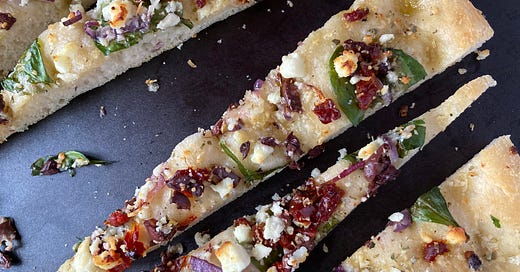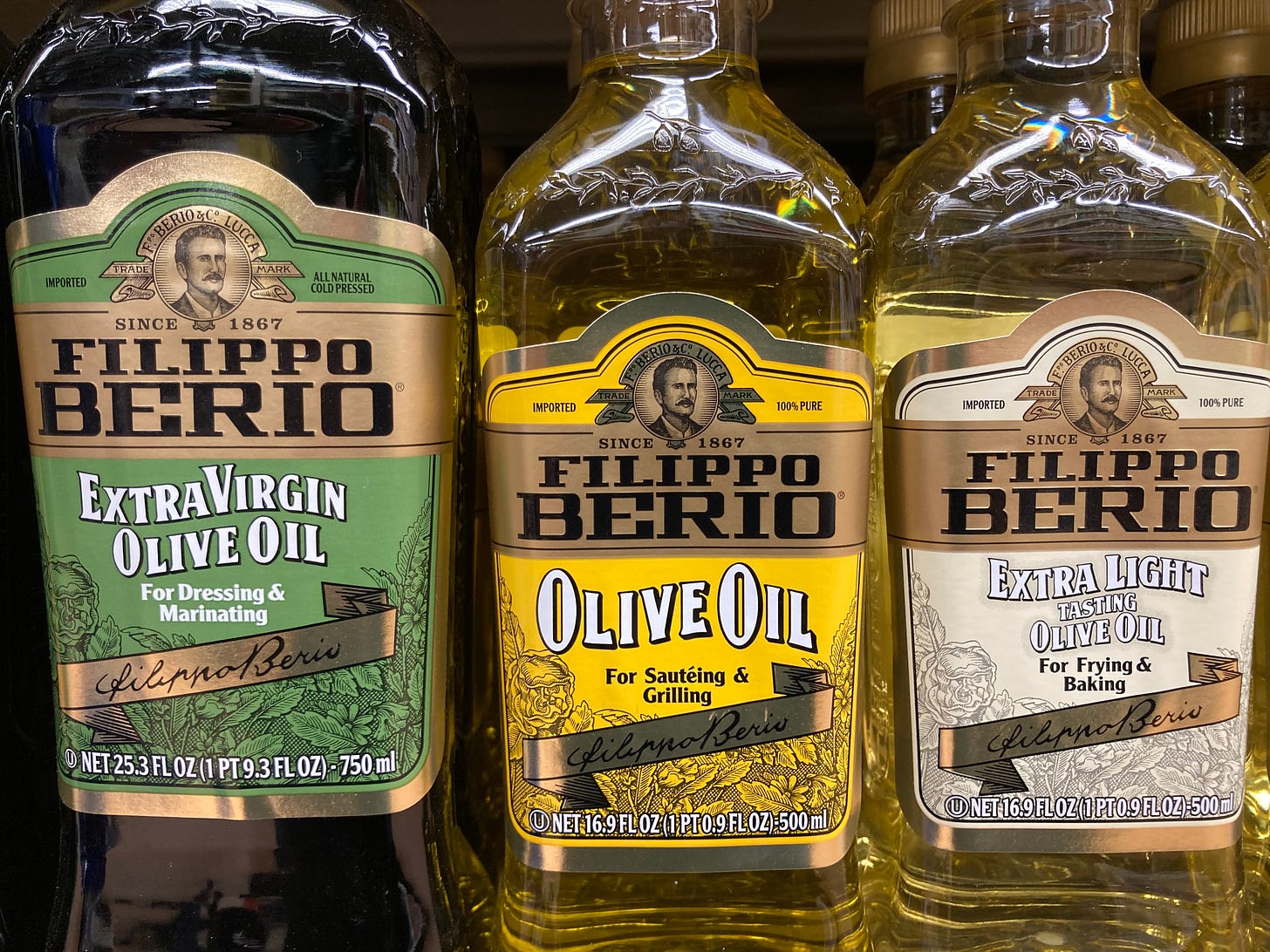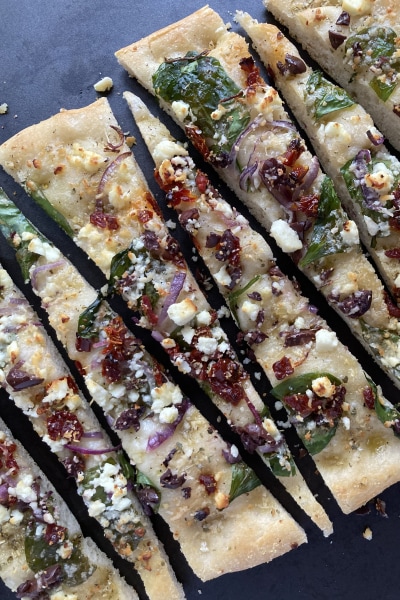Mediterranean-Inspired Focaccia
This classic, rustic, Italian bread is topped with spinach, sun dried tomatoes, olives, onion, and feta and parmesan cheese. Using thawed pizza dough makes this focaccia recipe so simple to assemble.
As the primary and treasured source of fat in the Mediterranean diet, olive oil has a distinct flavor and aroma that adds a wonderful taste to so many foods. But figuring out which type of olive oil to use when cooking takes a little investigating.
The terminology used to describe olive oil can be rather confusing. Cold pressed, extra virgin, and light are a few terms displayed on bottles of olive oil. Let’s take a look at what these descriptors mean and how it can influence olive oil selection.
First things first. When it comes to calories and fat content, all types of olive oil are the same. They all contain 120 calories per tablespoon, along with 14 grams of total fat and 2 grams of saturated fat. And they’re all rich in heart-healthy monounsaturated fat. The differences between various types of olive oils have to do with how they’re processed. The processing method influences the taste, color, and price of the oil.
Extra virgin and virgin. Extra virgin olive oil is a cold-pressed oil from the first pressing of the olives. Cold-pressing is a heat-free, chemical-free process used to extract the oil from the olives. Cold-pressed oils maintain much of the original flavor of the olives and are often referred to as unrefined oils. Extra virgin olive oil is considered the finest of the olive oils, it’s also the most expensive. The taste is fruity, with a distinct olive flavor and aroma. Because the flavor of extra virgin olive oil tends to break down at higher temperatures, save this pricier olive oil for very low or no heat cooking. It’s great for making salad dressings, marinades and pesto, or as a finishing oil drizzled over cooked pasta dishes or roasted vegetables.
Although not widely available, virgin olive oil is also a first-press oil. It’s similar to extra virgin olive oil but with a less fruity, olive flavor.
Olive oil and pure olive oil. Products simply labeled “olive oil” or “pure olive oil” contain a mix of refined olive oil and virgin olive oil. Refined means the oil was extracted from the olives using heat or chemical treatments. It lacks the rich flavor of extra virgin olive oil and is typically the least expensive type of olive oil. Use it for higher-heat cooking applications such as sautéing, grilling, and pan frying.
Light and extra light. The terms “light” and “extra light” refer to olive oils that are lighter in color and flavor, not lower in calories or fat. This type of oil might also be labeled “mild-flavored” or “extra light tasting.” The ultra mild flavor makes this olive oil ideal for baking. It can also be used for sautéing and pan frying.
All types of olive oil should be stored in a cool, dry place away from sunlight. Using it within 6 months of opening will give you the freshest tasting oil.
To your health,
Darlene
MEDITERRANEAN-INSPIRED FOCACCIA
Yield: 16 servings
Serving Size: 1 slice
Prep: 15 minutes
Ready: 35 minutes
INGREDIENTS
2 tablespoons cornmeal
1 pound pizza dough, thawed
3 tablespoons extra virgin olive oil
2 cloves garlic, minced
1/2 teaspoon dried oregano
1/2 teaspoon dried crushed rosemary
1/4 teaspoon kosher salt
1/8 teaspoon black pepper
3/4 cup fresh baby spinach leaves
1/4 cup sliced sun dried tomatoes
1/4 cup thinly sliced red onion
1/4 cup whole kalamata olives, diced
1/3 cup crumbled feta cheese
3 tablespoons grated parmesan cheese
DIRECTIONS
Preheat oven to 425 degrees. Dust a large, ungreased sheet pan with cornmeal. Press pizza dough into a 16-by-8-inch rectangle. If dough begins to shrink and retract somewhat while shaping it into a rectangle, loosely cover it with plastic wrap and allow it to rest for 5 to 10 minutes.
In a small bowl whisk together oil, garlic, oregano, rosemary, salt, and pepper. Remove plastic wrap from dough and reshape into a 16-by-8-inch rectangle. Brush entire surface of dough with seasoned oil. Using your fingers, make indents (dimples) over surface of dough. Top dough with spinach, sun dried tomatoes, onion, olives, feta cheese, and parmesan cheese.
Bake for 18 to 20 minutes. Let cool for 5 minutes before slicing. Slice into 16 pieces and serve.
Nutrition Information per Serving
108 Calories, 4 g Total fat, 1 g Saturated fat, 0 g Trans fat, 2 mg Cholesterol, 157 mg Sodium, 14 g Total carbohydrate, 1 g Dietary fiber, 1 g Total sugars, 0.5 g Added sugars, 3 g Protein, 1 mcg (6%) Vitamin D, 24 mg (2%) Calcium, 1 mg (6%) Iron, 34 mg (0%) Potassium
© 2023 RECIPES MADE HEALTHY BY DARLENE ZIMMERMAN, MS, RD LLC








You are so welcome Stacey! Thank you so much for your feedback - I really appreciate that.
Great question Sheryl. One good substitute for feta would be queso fresco. It looks almost identical to feta and has the same tangy, briny flavor. Or, you could just eliminate the feta and add a little extra parmesan cheese. Hope this helps.